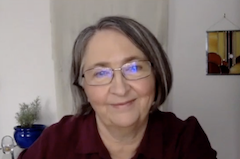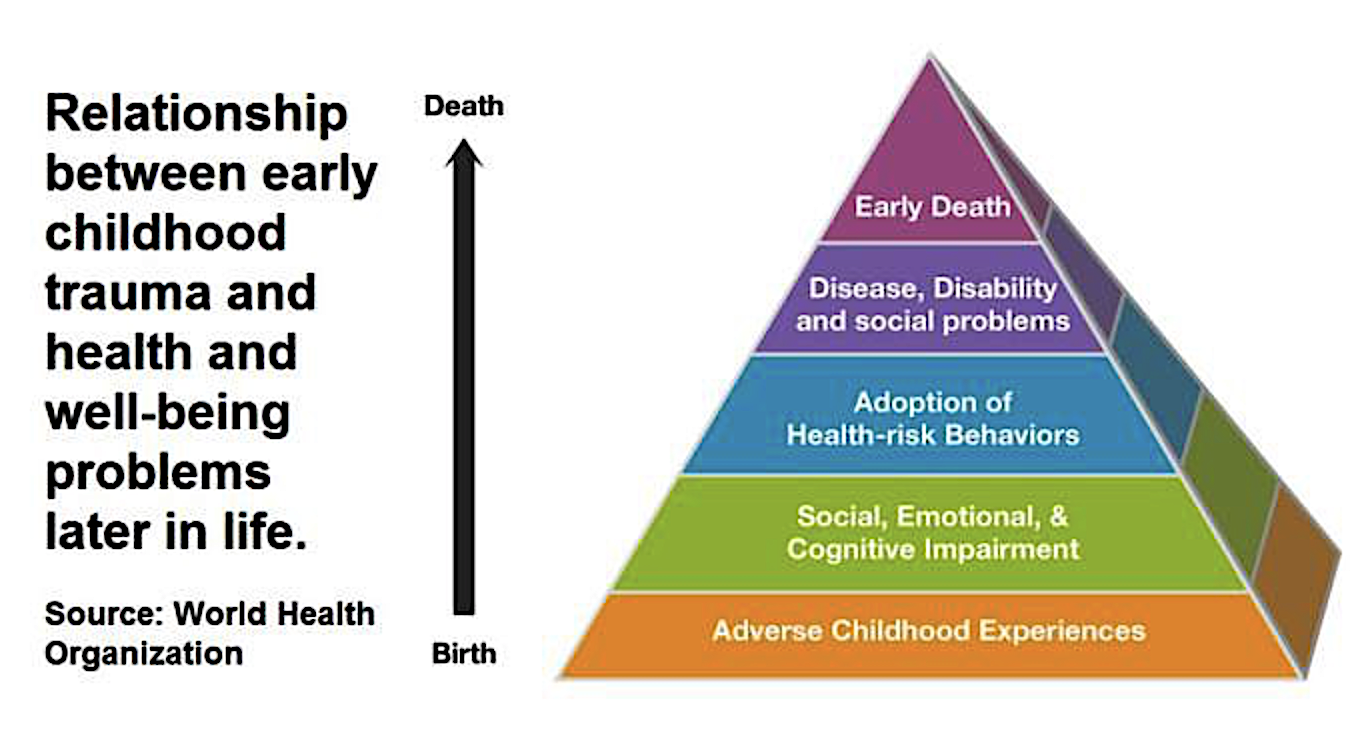This study is one of the largest investigations ever conducted (mid 90’s) to assess associations between childhood maltreatment and later-life health and well-being. It has since been studied in several states with similar results and they are continuing to follow the original participants.
Adverse Childhood Experiences (ACE) Study Pyramid
http://www.cdc.gov/violenceprevention/acestudy/
The ACE Study findings suggest that certain experiences are major risk factors for the leading causes of illness and death as well as poor quality of life in the United States. It is critical to understand how some of the worst health and social problems in our nation can arise as a consequence of adverse childhood experiences. Realizing these connections is likely to improve efforts towards prevention and recovery.
Two thirds of the people had at least one adverse experience. Several yes answers increases risk as an adult.
It is helpful to understand our lives and the impact of trauma. We are not personally at fault. This is how our brain and nervous system works. Maladaptive coping strategies arise as a result of trauma. Trauma CAN be healed. As we heal our nervous systems our risk of disease is lowered as well.
Limitations of the ACES questions:
The original ACES focused on maltreatment by parents or other adults in the home before the age of 18. There are many other sources of trauma.
Neuroplasticity of the brain was discovered in the late nineties. We now know that the brain continues to grow and develop throughout our lifetime based on our experiences. It is commonly acknowledged that childhood brain developmental processes continue to age 25.
Some relevant beliefs in the mid-nineties:
Childhood trauma of the type reflected in the ACES questions was thought to be relatively rare, perhaps 1 in 35 children. Current statistics indicate 1 in 4 girls and 1 in 6 boys have been sexually abused. When you consider other types of abuse and neglect, childhood trauma is common.
A number of measures indicate about a third of adults experience significant mental health issues, including addiction. This is in line with higher reported numbers of abuse.
It was commonly believed that addiction was a choice and a moral failing. More progressive people considered it a disease. Trauma experts like Dr Gabor Maté, MD now lead the way in seeing that addiction is a desperate attempt to avoid pain.
Bullying
Include trauma that takes place at school or in your community by adults or peers. See below for more about bullying.
Siblings
Include siblings and neighbourhood children as you’re reading ACES questions #1, 2, and 3 if nonconsensual.
ACES questions:
While you were growing up, during your first 18 years of life:
Answer Yes or No. If Yes, this counts as 1. Maximum score of ten.
1. Did a parent or other adult in the household often or very often…
swear at you, insult you, put you down, or humiliate you? Or act in a way that made you afraid that you might be physically hurt?
(Count 1 if either of these are true, not one for each one that is true)
Update: include siblings and neighbourhood children, include bullying at school, your community, and online.
2. Did a parent or other adult in the household often or very often…
push, grab, slap, or throw something at you? Or ever hit you so hard that you had marks or were injured?
Update: include siblings and neighbourhood children.
3. Did an adult or person at least 5 years older than you ever…
touch or fondle you or have you touch their body in a sexual way? Or attempt or actually have oral, anal, or vaginal intercourse with you?
Update: Include siblings and neighbourhood children unless it was peer-to-peer consensual exploration and you were not afraid or coerced to participate.
4. Did you often or very often feel that …
no one in your family loved you or thought you were important or special? Or your family didn’t look out for each other, feel close to each other, or support each other?
Update: Emotional neglect by parents, the experience of feeling unloved, leads children to believe they are fundamentally unworthy and unlovable.
Siblings often disconnect from each other as well as themselves.
5. Did you often or very often feel that …
you didn’t have enough to eat, had to wear dirty clothes, and had no one to protect you? Or your parents were too drunk or high to take care of you or take you to the doctor if you needed it?
6. Were your parents ever separated or divorced?
Update: It is now common with shared custody for children to move between homes and have stepparents and step siblings. Divorce and negotiating custody is overwhelming for the adults and they are often not consistently available to children who feel powerless and overwhelmed. Blended families are often a significant source of abuse, stress, uncertainty and fear.
7. Was your mother or stepmother…
often or very often pushed, grabbed, slapped, or had something thrown at her? Or sometimes, often, or very often kicked, bitten, hit with a fist, or hit with something hard? Or ever repeatedly hit at least a few minutes or threatened with a gun or knife?
Update: Male on female violence is most common. When you answer, include male on male, female on female, and female on male violence.
8. Did you live with anyone who was a problem drinker or alcoholic or who used street drugs?
Update: Include other substance and process addictions like gambling, sex, pornography, food, work, video games and shopping.
9. Was a household member depressed or mentally ill, or did a household member attempt suicide?
10. Did a household member go to prison?
Updates to the ACES questions:
The original ten questions created in the mid nineties were a good start. As you are considering your answers, broaden your scope to include all of your significant adverse childhood experiences. What happened in your childhood that caused you to be afraid? Shamed? Miserably unhappy? Isolated and alone? These are the experiences that cause our brain to fail to develop optimal neural networks for trust and connection and that cause deep and lasting fear in our nervous system.
In addition to the inclusions above, like bullying, consider these:
Did a parent or sibling have a significant chronic or life threatening illness or die when you were a child?
Are you a member of a group who experienced shaming and/or discrimination due to race? Economic status? Physical disability or difference? Gender? Sexual orientation or gender identity?
Did your family move a lot, uprooting you from secure friendships?
Did a significant friend move away, get sick or die?
Please add your own, then calculate your ACES score.
Refer to sources like this to understand what your ACES score means. High ACES scores do correlate with many negative outcomes as adults AND healing is always possible. We can heal trauma, see through core deficiency beliefs, calm the inner critic, restore health to our nervous system and build strength and resilience.
Bullying
http://www.thebullyproject.com/
What is Bullying? If it involves repeated, malicious attempts to humiliate a helpless victim, if the victim is fearful, does not know how to make it stop, then it’s bullying.
Bullying involves an individual or a group repeatedly harming another person physically (e.g. punching or pushing), verbally (e.g. teasing or name-calling), or socially (e.g. ostracizing or spreading hurtful rumors). Sometimes these harmful actions are plainly visible, but other times, such as when gossip and rumors are used to ostracize the target, the actions are covert.
According to the U.S. Department of Justice, bullying behavior might include assault, tripping, intimidation, rumor spreading and isolation, demands for money, destruction of property, theft of valued possessions, destruction of another’s work, and name-calling. With the advent of the internet, bullies are able to maintain a more persistent presence in the lives of their victims through electronic devices.
Bullying often does not happen in an isolated context with a single tormentor and victim. There may be multiple bullies or multiple victims, and there are almost always peers, adults, and other community members who know about the bullying taking place.
Often, the victims of bullying are socially vulnerable because they have some characteristic that makes them different from the majority. Young people who have physical or learning disabilities are also targeted more frequently, as well as students who are on the autism spectrum. Other times, there are no apparent characteristics that cause the target of bullying to be singled out by the tormentor.
Regardless, the person being bullied does not know how or does not have the power to make it stop. Recent research suggests that bullying is a common occurrence in United States schools. A 2011 nationwide study found that 40% of teachers and school staff consider bullying a moderate or major problem in their schools and that 32% of students between ages 12–18 report experiencing bullying.


